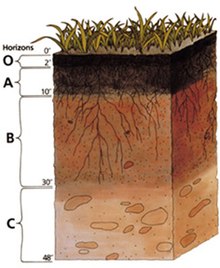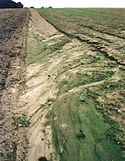Humus
The humus is the substance composed of certain organic products of a colloidal nature, which comes from the decomposition of organic remains by decomposing organisms and microorganisms (such as fungi and bacteria). It is characterized by its blackish color due to the large amount of carbon it contains. It is found mainly in the upper parts of soils with organic activity.
The organic elements that make up humus are very stable, that is, their degree of decomposition is so high that they no longer decompose and do not undergo considerable transformations.
Characteristics of humus
There are two kinds of humus, old or ancient humus and young humus.
- Old Humus. Due to a long period of time elapsed, it is very decomposed, it has a tone between purple and reddish; some humus-like humins are humins and humic acids. Humins are molecules of considerable molecular weight and are formed by interlacing of humic acids, being isolated they have the appearance of plastiline. Hymic acids are composed of a lower molecular weight and as well as humins have a high capacity for catyonic exchange (CIC), an important characteristic in plant nutrition. The old humus only physically influences the soils. It retains water and prevents erosion, also serving as a storage site for nutritious substances.
- Humus young. It is the one that has the characteristics of the newly formed, has a lower degree of polymerization and is composed of humic acids and foulvicos. The humic acids are formed by polymerization of the foulvic acids, the latter are formed from the decomposition of lignin. One of the main sources of humus is found in fireflies and fireflies. However, there are totally organic sources such as the humus de lombriz, the humus de termitas, the humus de cucarrón, among others, that besides providing water substances is much richer in beneficial microorganisms and nutritional elements and are more accepted in organic and ecological agriculture.
“Tilling bare soil repeatedly causes loss of humus. Dark soils turn ocher, lose their ability to retain and infiltrate water, and become more susceptible to erosion."

Humus can be formed by the simple oxidation of necromass in the absence of living organisms, but this process is greatly accelerated when living organisms ingest organic matter or secrete enzymes that transform it.
The organic matter that is the base of humus is mainly of vegetable origin, then microbial and animal during the transformation process, while the components of the deep soil are largely of mineral origin.
The raw material for humus is leaf litter and plant debris, combined with components of animal origin, deposited on the horizon A (name given to the soil surface by pedologists) or formed by animals that move the soil, including earthworms. This material evolves more or less rapidly (depending on the conditions of temperature, humidity, acidity or the presence of inhibitors, such as heavy or toxic metals), which leads to its transformation into relatively stable electronegative complex organic compounds. Depending on the size of the molecules produced, they are insoluble compounds (humin) or colloids (humic acids and fulvic acids), susceptible to migrating to the soil.
The presence of large amounts of metal cations in the soil, such as iron or calcium or even clay, makes humic and fulvic acids insoluble and prevents their migration, forming what is called brown soils. In the presence of small amounts of metal cations, the migration of small humic molecules (fulvic acid) causes small amounts of metals to exist in the surface horizons, forming the so-called podsols. The activity of burrowing animals (worms, ants, termites) contributes to rapid contact of humic compounds with mineral matter, thus avoiding their leaching and therefore their loss to ecosystems or agroecosystems.
The organic matter that decomposes and produces humus is made up of:
- vegetable fragments (sheets, stems, roots, wood, bark, seeds, pollen) in decomposition;
- exudados of roots and exudados of plants (propoleos) and animals (myslated) above the ground;
- excrements and excreta (mucosa, mucílagos) of worms and other microbial animals of the soil, of dead animals and many other microorganisms, such as fungi and bacteria.
All these elements are constantly being digested, displaced (bioturbation) and mobilized by a community of organisms called scavengers, saprophages or saprophytes: bacteria, fungi and invertebrates. In the cold or continental zone, the formation of humus accelerates in spring when the temperature rises and the humidity is high.
Humus can accumulate and grow very slowly in cold climates to become a carbon sink, but in hot climates it can mineralize and disappear very quickly. It is generally absent from tropical forests, but has been produced locally by man in the Amazon, from charcoal, a humus equivalent called Terra preta. Some very specific environments can show large accumulations of humified organic matter, which constitute carbon sink zones: these are peatlands in cold climates (mountains, boreal regions) and large accumulations observed in forests above & #34;white sand" in the tropics.
Humus constitutes an important reserve of organic matter in the soil. It is useful for the farmer, gardener or forester to know the total amount of humus and its quality. A clue to its quality is the carbon/nitrogen ratio of the soil. A C/N ratio of 10/1 (or less) indicates good soil biological activity, while a C/N ratio (20/1 or more) indicates a slowdown in this activity. The smell and the visual observation, as well as the microscopic observation of the organisms that compose it, provide information on the quality of humus, and, if necessary, the analysis of its chemical composition.
Humus, in the chemical sense of the term, is made up of free humus = humified organic matter, not bound with clay or metal oxides, and consolidated humus. Free humus is readily biodegradable (except in very acid or waterlogged soils) and easily migrates to the profile in well-drained soils. During the leaching process, there is a deep accumulation of non-biodegradable humic compounds, which can form complexes with metals. Consolidated humus is more stable and is more interesting in agricultural uses due to its longevity and its cationic and anionic exchange capacity (CEC).
Depending on whether humus has formed in aerated soil or not (for example, due to water saturation or repeated compaction) it can be classified into two categories:
- Humus formed in aerobic conditions
- The mull, with good incorporation of organic matter and mineral matter produced mainly by earthworms, present in forests of intense biological activity and in grasslands. Thus we find waste (sheets) of the previous year or the previous autumn, and a layer of variable thickness of organic-mineral brown material. The soil is rich in nutrients, mineralization is fast: it is an ideal environment for earthworms, except where the soil is calcareous. In tropical areas (sabana) and sub-desert environments, the mull can be produced by other excavating organisms, such as termites and Tenebrionidae insects.
- The moderating, with a surface layer of unincorporated organic matter, humified by fauna and fungi, present in forests and land, has an average biological activity. During the autumn, the leaves of the year are fallen and subjected to decomposition, mainly by mushrooms, but also the leaves of the previous year are partially decomposed, reduced to their network of nerves or nerves (skeletonized), with filaments of many fungi, roots (microughs) and above all of excrements of the animals that live in the leafy thickness and the millimetres. Its scent of mushrooms is characteristic.
- The mor, with a shallow layer of organic matter little or nothing humified, present in the forests and moors of low biological activity, which slows down the speed of decomposition of the plant remains. This leads to soil acidification and a rotting phenomenon. The thickness of this type of humus may be considerable, but it is not a criterion for identification. The passage of fire is often the means by which this form of humus finds its balance and allows the vegetation to recover, restoring to the ground the nutrients immobilized in the organic layer.
- Humus formed in anaerobic conditions
- The peat, which contains a lot of identifiable plant residues, sometimes very old, of several thousand years. This is a real archive of the environment. The mob is formed in permanently flooded environments, in the presence of a dense aquatic and high-growth vegetation (musgos de turbera, grande juncias, glycerias, etc.). The mob contains many grains of pollen that allow to rebuild the history of the landscape to very ancient times.
- The anmoor, which contains a lot of humid organic matter mixed with clay. The anmoor is formed in temporarily flooded media, as in swamps and along the rivers, the drying phase allows the biological processes leading to the development of humification.
The clay-humic complexes (CAH) are formed by the combination of clays and humus, both in a flocculated state, followed by the work of soil microorganisms, and especially earthworms., which thanks to its presence in a liquid medium (such as in a test tube) can unite these molecules (negatively polarized) by a bivalent cation: calcium (Ca2+). It seems that the mucus of some organisms may also play a role in the formation of these complexes that become stable and insoluble once dry (like cement when it "sets"), which explains the resistance of humus to water and erosion and the maintenance of its structure and its exceptional capillarity.
The destruction of humus
The contributions of biocides, pesticides, and fertilizers can degrade or eliminate humus.
Tillage destroys humus by burying it, causing very rapid mineralization of organic matter and soil loss that can reach 10 tons/year in temperate zones and up to several hundred tons in the tropics.
The loss of humus is also reflected in a glacis phenomenon in tilled soils, which considerably reduces their capacity to absorb water. Soils contaminated by pesticides and excess nitrates (responsible for the increase in green algae and cyanobacteria visible on the ground) carry away fine particles that increase the turbidity of rivers and streams.
Today, there are many methods for cultivation without destroying the humus: organic farming, no-till, chipped branch wood, natural farming, regenerative farming.
Physical influence of humus
- It increases the ability to exchange cayonic soil.
- It is consistent with light soils and compacts; in compact sandy soils while in clay soils it has a dispersion effect.
- It makes it easier to till the earth by improving the physical properties of the soil.
- Avoid crust formation, and compaction.
- It helps with water retention and water draining.
- Increases the porosity of the soil.
- It has high contents of K and S, in addition to a high microbial load as well as humic and foul acids, decompacting the soil and facilitating the taking of nutrients by the ridge.
Chemical influence of humus
- Regulates plant nutrition.
- Improves the exchange of ions.
- Improves the assimilation of mineral fertilizers.
- It helps with the potassium and phosphorus process on the ground.
- It produces carbonic gas that improves the solubility of minerals.
- It provides nitrogenic products to degraded soil.
- The microbial flora of the plants rises.
- Carbon sequester.
Biological influence of humus
- It provides useful microorganisms to the ground.
- It serves both the support and food of microorganisms.
Contenido relacionado
Hogwarts School of Witchcraft and Wizardry
Monforte de la sierra
Back to the Future
Klaus kinski
10 (film)



